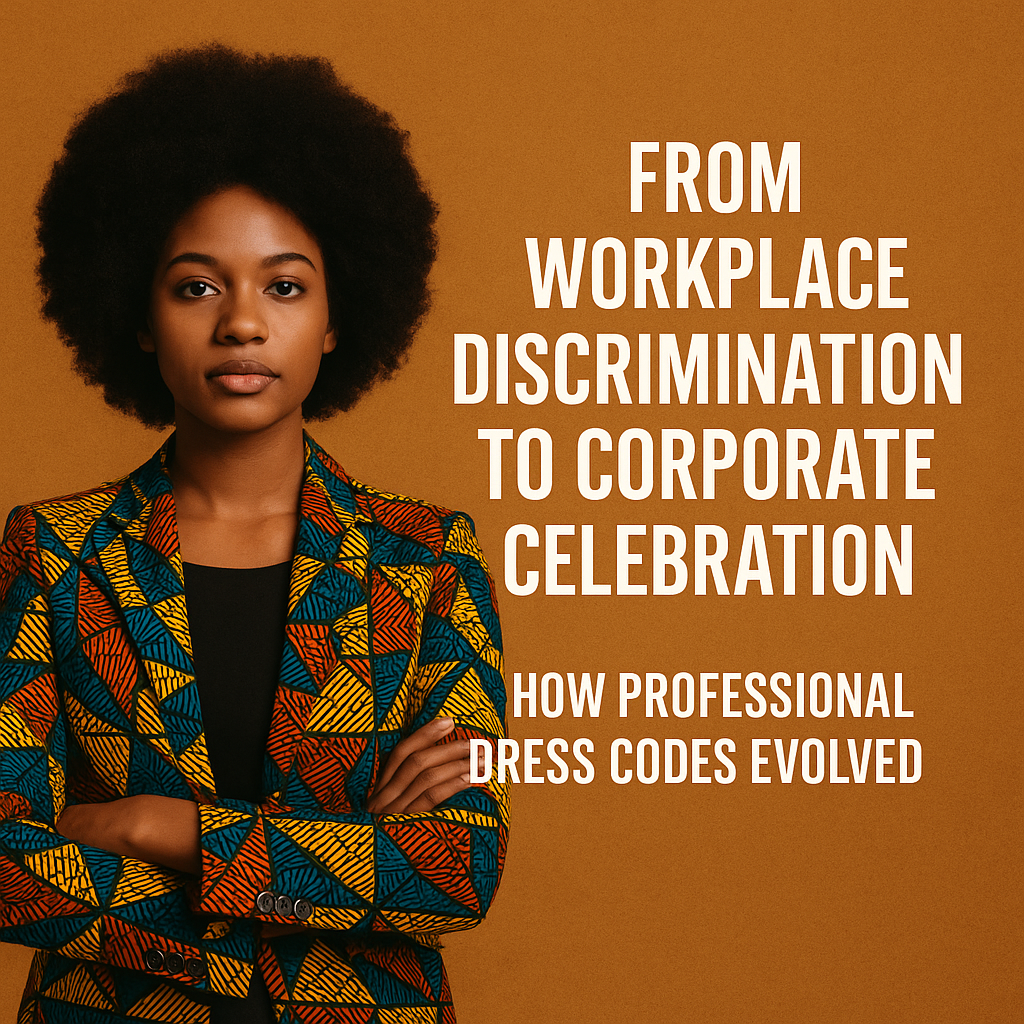
From Workplace Discrimination to Corporate Celebration
Share
From Workplace Discrimination to Corporate Celebration: How Professional Dress Codes Evolved
In the third installment of our “Threads Across Time” series from LoudThread™ we explore one of the most dramatic transformations in American workplace culture: how African-inspired fashion and natural hairstyles went from being punished to being celebrated as symbols of diversity and inclusion.
The Unwritten Rules of "Professional" Appearance
For decades, American workplaces operated under an invisible but iron-clad dress code. “Professional” had a particular look — modeled after white, European aesthetics. Anything that deviated was labeled “unprofessional,” “distracting,” or “inappropriate.”
This wasn’t just a matter of preference — it was systematic exclusion disguised as policy.
The 1960s–1980s: When Culture Was Career Suicide
The Rigid Reality:
-
Natural hair was considered “unkempt” regardless of style
-
African-inspired jewelry was deemed “too ethnic.”
-
Headwraps and turbans were banned as “non-business attire”
-
Colorful patterns were considered “unprofessional” compared to muted suits
Real Stories of Discrimination:
-
A Detroit teacher was suspended in 1976 for refusing to remove her headwrap
-
A Chicago insurance worker was dismissed in 1982 for wearing a dashiki to a company picnic
-
Black women faced discipline in the late 1970s for wearing natural hair
These weren’t isolated incidents. Black professionals had to “code-switch” not only in language but in style — leaving cultural identity at the office door each morning.
The Strategic Compromises of the 1990s–2000s
Civil rights progress brought some changes, but restrictions lingered.
The “Acceptable” Middle Ground:
-
Natural hair allowed only if styled “conservatively”
-
Cultural clothing is limited to special occasions
-
African-inspired accessories permitted if “understated”
The Emotional Tax:
This era created what researchers now call “covering” — the pressure to downplay identity to fit in. Professionals spent enormous energy calculating how much culture was “too much” for their environment.
The Turning Point: Legal Victories and Cultural Shifts
Key Legal Moments:
-
Rogers v. American Airlines (1981): While unsuccessful, it sparked a national debate
-
Jenkins v. Blue Cross (1985): challenged grooming bias
-
EEOC rulings in the 1990s confirmed that dress codes could not discriminate based on race
Cultural Momentum:
-
The rise of Afrocentrism in the 1990s made cultural expression more visible.
-
Hip-hop culture brought African-inspired fashion into popular culture
-
Increased media representation normalized natural hair and traditional prints
The 2010s: Social Media Changes Everything
Discrimination was no longer hidden in isolated offices — it was exposed online.
Viral Movements:
-
#NaturalHair hashtags showcasing professional pride
-
Corporate diversity campaigns featuring employees in cultural dress
-
LinkedIn posts of professionals in African-inspired attire are going viral
-
Public backlash against companies enforcing discriminatory policies
The CROWN Act: Legal Protection Arrives
Since 2019:
-
The CROWN Act outlawed discrimination based on natural hair and protective styles
-
Extended protection to headwraps and cultural dress
-
Forced employers to revise outdated policies
-
Provided legal recourse for employees facing appearance-based discrimination
At LoudThread™, we document these struggles and victories as part of our mission to show how cultural fashion isn’t just style — it’s history woven into fabric.
2020–2025: The Great Workplace Awakening
Social justice movements accelerated inclusion at unprecedented speed.
The New Corporate Reality:
-
Fortune 500 companies celebrate cultural dress in campaigns
-
Executives proudly wearing African prints in leadership spaces
-
Employee resource groups hosting cultural fashion showcases
-
Recruitment highlighting inclusive dress policies
From Tolerance to Celebration:
What was once barely tolerated is now encouraged and admired.
The Ongoing Evolution
Challenges that remain:
-
Conservative industries still lag behind
-
Regional differences persist
-
Older managers sometimes resist change
Opportunities emerging:
-
Mentorship connecting young professionals with pioneers
-
Supplier diversity partnerships with Black-owned fashion brands
-
Education programs teaching the significance of cultural dress
What This Means for Today’s Professionals
New Freedoms:
-
Natural hair is widely embraced as professional
-
African-inspired fashion is seen as sophisticated and global
-
Cultural expression enhances careers instead of harming them
Continuing Responsibility:
Each professional who chooses authenticity helps normalize it for the next generation.
Beyond Fashion: The Larger Shift
The evolution of workplace dress reflects more than clothing — it signals a deeper shift in how businesses view identity, inclusion, and innovation.
Lessons learned:
-
“Professional” was never neutral — it was cultural
-
Authentic expression improves engagement and retention
-
Cultural competence has become a business advantage
Looking Forward
As of 2025, young professionals enjoy freedoms their parents and grandparents could not. But they are also shaping the next chapter — one where authentic cultural expression is simply regular.
Emerging Trends:
-
Sustainable cultural fashion is gaining traction in corporate responsibility
-
Global exchange through remote, multicultural teams
-
AI hiring tools are being checked for appearance bias
-
Gen Z leadership embedding authenticity-first values
Honoring the Journey
Today’s freedoms rest on the sacrifices of those who risked careers for authenticity. Every professional walking confidently into a boardroom wearing their heritage continues that legacy.
The threads of progress are woven with both struggle and triumph. At LoudThread™, every collection and every story we share is part of that ongoing journey — from discrimination to celebration, from silence to pride.
Share Your Workplace Fashion Story
Have you experienced this evolution firsthand? We’d love to hear about your journey. Email us at info@loudthread.com to be featured in our ongoing Threads Across Time series.
Next week: “The Art of Cultural Fusion: How Young Designers Are Reimagining African-Inspired Fashion for Global Audiences.”
